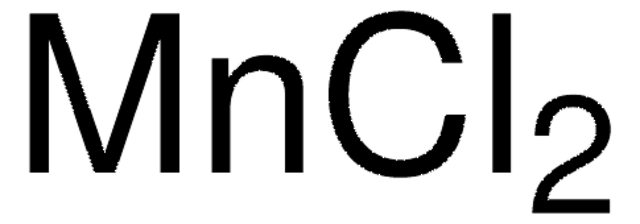M3634
Manganese(II) chloride tetrahydrate
ReagentPlus®, ≥99%
About This Item
Recommended Products
grade
reagent
product line
ReagentPlus®
assay
≥99%
form
powder
pH
3.5-6 (25 °C, 50 g/L)
mp
58 °C (lit.)
SMILES string
Cl[Mn]Cl.[H]O[H].[H]O[H].[H]O[H].[H]O[H]
InChI
1S/2ClH.Mn.4H2O/h2*1H;;4*1H2/q;;+2;;;;/p-2
InChI key
CNFDGXZLMLFIJV-UHFFFAOYSA-L
Looking for similar products? Visit Product Comparison Guide
General description
Application
- As a promoter to synthesize dihydropyrimidin-2(1H)-ones by the condensation of aldehyde, β-dicarbonyl compounds, and urea under microwave conditions.
- As a catalyst to synthesize dihydro-2-oxypyrrole derivatives via one-pot four-component domino condensation of dialkyl acetylenedicarboxylate, formaldehyde, and amines.
- To synthesize active manganese oxide with potential application as an oxidant in organic synthesis.
Legal Information
signalword
Danger
hcodes
Hazard Classifications
Acute Tox. 3 Oral - Eye Dam. 1 - STOT RE 2
target_organs
Brain
Storage Class
6.1D - Non-combustible acute toxic Cat.3 / toxic hazardous materials or hazardous materials causing chronic effects
wgk_germany
WGK 2
flash_point_f
does not flash
flash_point_c
does not flash
Choose from one of the most recent versions:
Certificates of Analysis (COA)
Don't see the Right Version?
If you require a particular version, you can look up a specific certificate by the Lot or Batch number.
Already Own This Product?
Find documentation for the products that you have recently purchased in the Document Library.
Customers Also Viewed
Our team of scientists has experience in all areas of research including Life Science, Material Science, Chemical Synthesis, Chromatography, Analytical and many others.
Contact Technical Service








